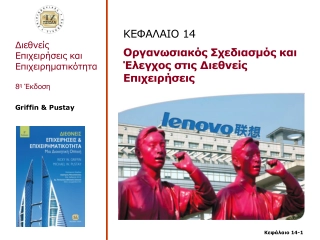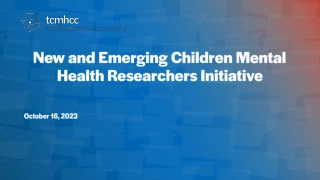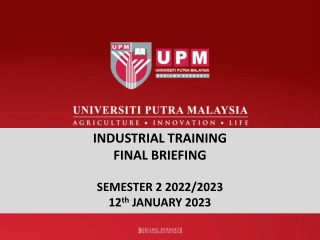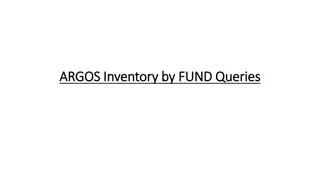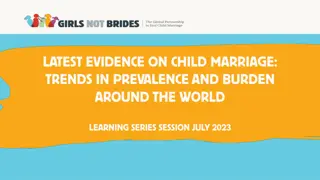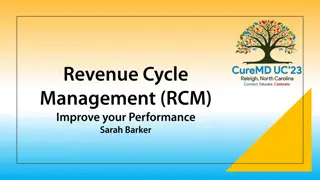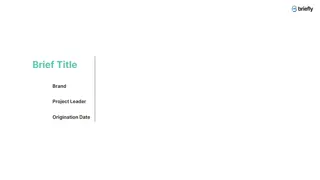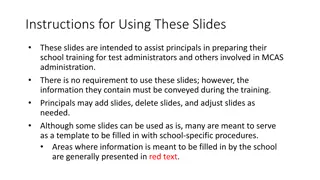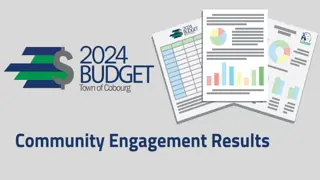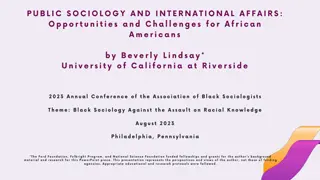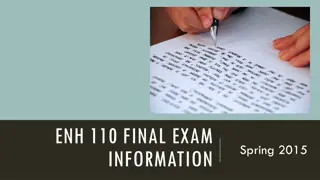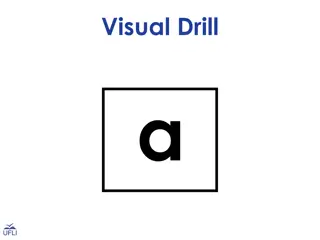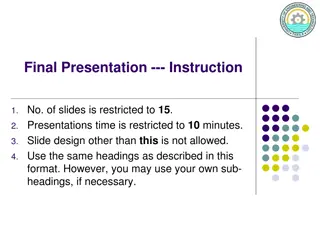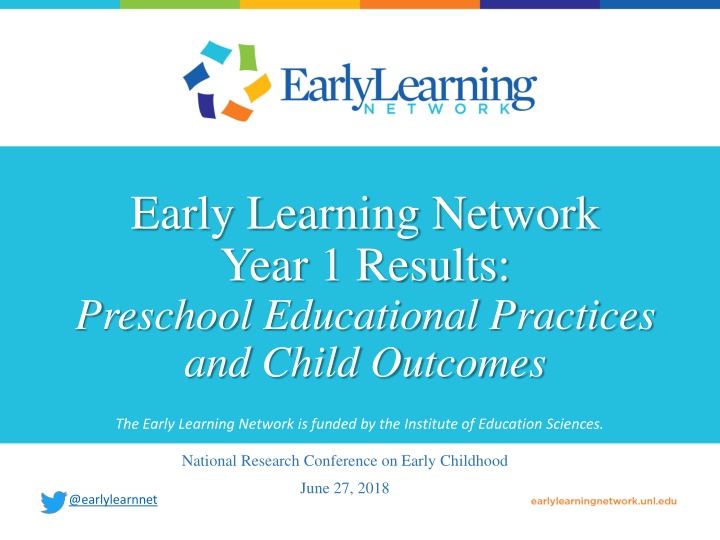
Early Learning Network Year 1 Results: Preschool Educational Practices and Child Outcomes
Explore the findings from the Early Learning Network's research conducted to enhance the understanding of policies and practices supporting early learning success as children transition from preschool to elementary school. Dive into the symposium agenda chaired by Susan Sheridan and papers presented on classroom quality, pre-K gains in rural areas, and more.
Download Presentation

Please find below an Image/Link to download the presentation.
The content on the website is provided AS IS for your information and personal use only. It may not be sold, licensed, or shared on other websites without obtaining consent from the author. If you encounter any issues during the download, it is possible that the publisher has removed the file from their server.
You are allowed to download the files provided on this website for personal or commercial use, subject to the condition that they are used lawfully. All files are the property of their respective owners.
The content on the website is provided AS IS for your information and personal use only. It may not be sold, licensed, or shared on other websites without obtaining consent from the author.
E N D
Presentation Transcript
Early Learning Network Year 1 Results: Preschool Educational Practices and Child Outcomes The Early Learning Network is funded by the Institute of Education Sciences. National Research Conference on Early Childhood June 27, 2018 @earlylearnnet
The Early Learning Network aims to advance the understanding of policies and practices that narrow the achievement gap and maintain early learning success as children transition from preschool to elementary school and beyond.
Five Research Teams One Assessment Team Network Lead
Complementary Research Studies Descriptive study: Identify systems-level policies and practices that support early learning Classroom observation study: Identify teaching practices and other classroom-level malleable factors associated with children s school readiness and achievement in preschool and early elementary school Longitudinal study: Identify malleable factors associated with early learning and school achievement over time from preschool through the early elementary school grades
Symposium Agenda Chair: Susan Sheridan, ELN Lead (University of Nebraska-Lincoln) Paper 1: How Does Quality of Curricular Implementation Support Diverse Children s Skills in Prekindergarten?: Evidence from Boston JoAnn Hsueh, Meghan McCormick, Michelle Maier, Christina Weiland, Jason Sachs, Catherine Snow (MDRC & Partners) Paper 2: Pre-K classroom Characteristics and Pre-K Gains of Children Living in Rural Areas Peg Burchinal, Irina Mokrova, Mary Bratsch-Hines, Ellen Peisner-Feinberg (UNC) Paper 3: Classroom quality and classroom network structure: Interplay and prediction of student outcomes Jessica Logan, Jing Chen, Laura Justice, Tzu-Jung Lin, Kelly Purtell (OSU) Paper 4: Understanding the Effects of Classroom Processes on Child Outcomes in Pre-kindergarten Bob Pianta, Ginny Vitiello, Jessica Whittaker, Erik Ruzek, Tara Hofkens & Arya Ansari (UVA) Discussant: Sara Vecchiotti, Foundation for Child Development
How Does Quality of Curricular Implementation Support Diverse Children s Skills in Prekindergarten?: Evidence from Boston JoAnn Hsueh Meghan McCormick Michelle Maier Christina Weiland Jason Sachs Catherine Snow June 27, 2018 National Research Conference on Early Childhood
The BPS Model as a Case Study for Examining Fidelity of Implementation Curriculum in place Example components adapted from OWL Example Building Blocks components Example district- developed components Focus on K1 (district-adapted version of Opening the World of Learning & Building Blocks). Thematic curriculum that cuts across ELA, math, science, social study, and arts. Centers & Introduction to Centers Building Blocks centers Thinking & feedback; SWPL; Let s Find Out About It Read Aloud Building Blocks whole group activities Storytelling Small Groups to support language/literacy Building Blocks small group activities Storyacting
Research questions 1. What does fidelity look like across prekindergarten public school classrooms in BPS? 2. What measures of fidelity are most closely associated with CLASS? 3. Is fidelity to the BPS PreK model associated with children s language and math scores in the Spring of PreK? For which groups of students does fidelity appear most predictive of Spring outcomes (e.g., dual language learners, racial/ethnic minority students)?
Research & BPS teams Co-construct Tool to Measure Fidelity of Implementation Research team conducts in- depth curriculum review and meets with BPS staff Research team develops fidelity tool and iteratively edits it following meetings with BPS staff Training and reliability procedures take into account BPS staff feedback Further edits and adaptation following field- based piloting with BPS staff BPS instructional coaches collect data in classrooms
Fidelity Data in Public School Classrooms 41 total public prekindergarten classrooms participated (97% of teachers in participating schools) N = 41 classrooms in 20 schools Each classroom observed on two separate days for 2 3 Classrooms observed 2x hours/obs. Observation data averaged across days. 20% of observational visits were coded by two BPS coaches; Reliability analysis suggests high agreement. Reliability
Classroom & teacher participants (N = 41 public school classrooms across 20 schools) Teacher characteristic %age/Mean Teacher age 43.95 (SD = 9.37) Years teaching 14.79 (SD = 9.25) Years teaching prekindergarten 8.6 (SD = 7.37) Years teaching at current school 7.79 (SD = 8.01) Teacher has master s degree 90% Teacher female 100% Teacher Black 22% Teacher White 49% Teacher Hispanic 13% Teacher Asian or other race 16% Classrooms per school 1.35 (SD = .42)
Summary of Fidelity Data for BPS K1 Classrooms Component % classrooms component observed Centers 100% Intro to Centers 95% Read Aloud 93% SWPL 80% Building Blocks Whole Group 66% Small Group, Language/Literacy 63% Building Blocks Centers 49% Building Blocks Small Group 41% Thinking & Feedback 32% Storytelling 15% Story-acting 12% Let s Find Out About it 7%
Cross-component fidelity measures Vocabulary ( = .91) Extending/Building ( = .91) Summary/ Reflection/Making Connections ( = .79) Scaffolding/ Differentiation ( = .82)
What does fidelity look like overall in BPS public school prekindergarten classrooms? 5 4.5 Fidelity score (1 - 5) 4 3.5 3 2.5 2 1.5 1
How does this compare to CLASS scores? 7 6 CLASS Domain Scores 5 4 3 2 1 Emotional support Classroom organization Instructional support
How do fidelity measures relate with CLASS? Instructional support Emotional support Classroom org. Instructional support 1.0 Emotional support .67 1.0 Classroom org. .69 .85 1.0 Extending/Building .18 .16 .10 Summary/Reflection .22 .10 .14 Vocabulary .01 .01 -.07 Scaffolding/Differentiation .35 .21 .22
How does implementation vary depending on classroom composition? There are some differences in implementation between classrooms. On average: Classrooms with higher percentages of white students have higher quality of implementation Classrooms with higher percentages of black and Hispanic students have lower quality of implementation Classrooms with higher percentages of DLLs have similar quality of implementation as classrooms with fewer DLLs, but more variation across classrooms.
Links between fidelity of implementation and improvements in language and math across prekindergarten year Full sample of students - no significant associations between cross-component fidelity measures and gains in language or math across prekindergarten year No significant associations detected in this preliminary work using cross-component fidelity constructs to predict PPVT outcomes Statistically significant interactions between fidelity of implementation, Hispanic and DLL status, and math outcome
Example of Predicted Math Skills for Hispanic Students at End of Prekindergarten Year 104 WJ Applied Problems Standard Score 103 102 101 100 High fidelity 99 Low fidelity 98 97 96 95 Extending/building Summary/reflection
Example of Predicted Math Skills for White Students at End of Prekindergarten Year 120 WJ Applied Problems Standard Score 115 110 High fidelity Low fidelity 105 100 95 Extending/building Summary/reflection
Example of Predicted Math Skills for Dual Language Learner Students at End of Prekindergarten Year 110 WJ Applied Problems Standard Score 109 108 107 106 105 High fidelity 104 Low fidelity 103 102
Some preliminary conclusions Reliable fidelity data can be collected by district staff. Systematic variation in fidelity across classrooms. Fidelity may predict math outcomes (on a small magnitude) but story is likely in the subgroups for a diverse sample with varying skill levels at baseline and follow-up.
Limitations & Next Steps Work is very preliminary and in early stages Future models will include more rigorous work to determine covariates and alternative model fits. More measurement work needed to operationalize fidelity constructs and consider any within- component measures of adherence, dosage, quality Data are correlational across one school year Sample is fairly small in Year 1 study (particularly for subgroups); future years will include larger samples for subgroup examination
Acknowledgments MDRC Marissa Strassberger Rama Hagos Sharon Huang Jared Smith Desiree Alderson Ilana Blum Kelly Terlizzi Mirjana Pralica University of Michigan Deborah Ball Lillie Moffett Paola Rosado Amanda Ketner Harvard Nonie Lesaux Sibyl Holland Maia Gokhale Data collection team BPS Brian Gold Abby Morales Marina Boni Melissa Luc David Ramsey BPS Dept. of Early Childhood Staff
Funding Acknowledgment The research reported here was supported by the Institute of Education Sciences, Department of Education, through Grant R305N160018 17 to MDRC. The opinions expressed are those of the authors and do not represent views of the Institute or U.S. Department of Education.
Questions? JoAnn Hsueh MDRC joann.hsueh@mdrc.org Meghan McCormick MDRC meghan.mccormick@mdrc.org Michelle Maier MDRC meghan.mccormick@mdrc.org Christina Weiland University of Michigan weilandc@umich.edu Jason Sachs Boston Public Schools jsachs@bostonpublicschools.org Catherine Snow Harvard Graduate School of Education Catherine_snow@gse.harvard.edu
Peg Burchinal Irina Mokrova Mary Bratsch-Hines Ellen Peisner-Feinberg University of North Carolina at Chapel Hill
ECE can reduce achievement gap State and federal preschool programs But questions remain: Which child outcomes are promoted by which aspects of preschool ECE?
Process quality Teacher sensitivity and classroom management relate to socio-emotional outcomes, Widely examined; modest associations Verbal interactions with adults T-C conversations relate to language Verbal literacy instruction relate to literacy skills Less widely examined; modest associations
Instruction time More time in content area relates to gains in that skill Less widely studied: modest associations Setting Small groups help young children learn Centers provide children with hands-on learning opportunities: Cornerstone of ECE instruction Curriculum Wide-scale belief in whole child curricula Moderate to strong evidence for some domain-specific curricula
Cohort study of rural NC 6 NC rural counties 63 randomly selected NC Pre-K classrooms Pre-K children 351randomly selected children 34% Spanish-English dual language learners ECE dimensions Classroom observations Teacher report of curriculum
Classroom observed Day 1 CLASS High quality instructional practices adapted Boston pre-K fidelity checklist Combined alpha =.90 Day 2 Language Interaction Snapshot (LISn)- summarized for classroom Time sampling observations of individual children 30 second recording of language exchanges 5 minute recording of setting and activity 4-6 cycles for 6 or more children
Process quality 7 6 5 4 3 2 1 Total CLASS Emotional Support CLASS Classroom Organization CLASS Instructional Support BPS Global Rating
Language Interaction Snapshot 1 0.8 0.6 0.4 0.2 0 Complex Language Exchanges Literacy Activities Phonics Activities Math Activities
Teacher Report 1 0.8 0.6 0.4 0.2 0 Creative Curriculum Tools of Mind Opening Word of Learning High Scope
N 62 61 61 61 61 61 61 61 59 % Mean Sd High Quality Practices Teachers: complex language Instructional Time Literacy Activities Phonics Activities Math Activities Grouping Small Group Whole Group Free Choice/Center Creative Curriculum 4.17 0.66 0.04 0.03 0.23 0.12 0.05 0.05 0.16 0.13 0.08 0.11 0.36 0.18 0.48 0.19 78%
Process Quality Process Quality Complex conver sation Complex conver- - sation Literacy Activities Literacy Activities Sounds Activities Sounds Activities Math Activities Math Activities Small Group Small Group Whole Group Whole Group Creative Curric Creative Curric. . Process quality .27* .16 -.04 .13 -.10 .25* .20 Complex conver- sation .34** .24+ .47*** .35** .07 -.18 Literacy Activities Sounds Activities Math Activities Small group .63*** .05 .01 .21+ -.24+ .12 .00 .05 -.37** .50*** .06 -.34** -.27* -.24+ Whole group -.13
Collected fall and spring Measures Expressive One Word Picture Vocabulary Woodcock Johnson III Letter Word Applied Problems DIBELS First Sound Fluency Phonemic Segmentation Fluency NIH Tool Box Flankers (inhibitory control) Dimensional Card Sort (cognitive flexibility)
Standardized Child Outcomes 104 *** * 102 *** 100 98 96 94 92 90 88 86 Language -EOW Decoding - WJ3 LW Numeracy-WJ AP EF-Flankers EF-DCC Fall Spring
Gains in Child Outcomes-raw or W scores Expressive One Word N Mean SD 345 7.14* 11.93 WJ3 Letter Word Identification 352 21.05*** 19.73 DIBELS First Sound Fluency 351 3.86* 8.96 DIBELS-Phonemic Segmentation 350 2.89* 8.39 WJ3 Applied Problems 352 18.66*** 18.71 NIH Tool Box-EF: Flanker 341 8.74* 13.18 NIH Tool Box-EF: Dimensional Card Sort 332 7.00* 15.89
Gain scores analyzed Model Level 1: Yijk = dojk+ d1jk <child covariates> + eijk Level 2: dojk = Bo + B1High Quality Practicesjk + Backwards elimination to check findings B2 T Complex Languagejk + B3 Content Activitiesjk + B4 Small Groupjk + B5 Whole Groupjk + B6 Creative Curriculumjk + ejk
Language EOW Language EOW Literacy WJ LW Literacy WJ LW Letters DIBELS FSF Letters DIBELS FSF Phonemic DIBELS PSF Phonemic DIBELS PSF Math WJ AP Math WJ AP EF Flankers EF Flankers EF Card Sort EF Card Sort .19** Process Quality Complex Conversation -.14** Instruction: Literacy Sounds Math Small Group .21* .16** -.17* Whole Group -.12* -.17** Creative curriculum -.17**
Surprisingly sparse findings No one ECE dimension predicted all outcomes Best predictors Instructional time: positively related to gains in language and specific literacy skills Whole group: negatively related to gains in language and math Curriculum: negatively related to gains in literacy Process quality: mixed, positive gains-decoding, negative gains inhibitory control
May need attend to Other ECE dimension in addition to process quality Measures of individual child experiences as well as measures of teachers Different predictors for different outcomes need to be strategic in what ECE dimenions should be promoted for specific child outcomes
To all participating families, teachers, and school administrators To all research assistants and project staff To the Institute of Education Sciences
Classroom quality and classroom network structure: Interplay and prediction of student outcomes Jessica Logan, Jing Chen, Laura Justice, Tzu-Jung Lin, Kelly Purtell The Ohio State University NRCEC 6/27/2018
Early Learning Ohio Team Key Project Staff: Jennifer Bostic Allie Hamilton Janelle Williamson Katie Filibeck Lauren Barnes Anna Rhoad-Drogalis Hui Jiang Jing Chen Principal Investigator: Dr. Laura Justice Co-Investigators: Dr. Tzu-Jung Lin Dr. Jessica Logan Dr. Kelly Purtell
Early Learning Ohio Broad goal: Expand our understanding of classroom ecology A comprehensive examination of the classroom ecology and its relations with children s learning PreK grade three.
Classroom Network Children s language and social skills are shaped by who is around them Complexity of teacher talk (e.g., Justice et al., 2013) The skills of their peers (e.g., Justice, Logan, Lin, & Kaderavek, 2016) Classroom social networks directly measure who children spend time with, and can be characterized Children s academic growth is likely affected by both classroom quality and the nature of the social network created by their peers (Gest et al., 2014) Children s language is significantly predictive of classroom density in preschool (Chen et al., 2017). Higher language scores more dense classrooms

